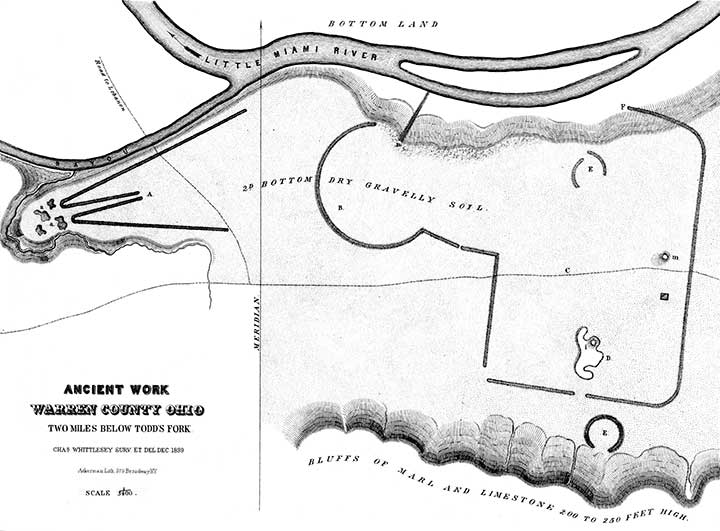PLATE II.
ANCIENT WORK, NEAR TODD'S FORK, WAREEN COUNTY, OHIO.

This sketch exhibits very little that is different from the works commonly seen in Ohio, and heretofore described, except the raised part, D, which is analogous to the effigy-mounds described by Dr. Locke, Mr. Taylor, and others, in the north-west. The land had been some years under cultivation (1839), and possibly the full figure was wanting; but, as it was when surveyed, the resemblance to an animal or even a monster was not very striking. If the semblance of legs had been seen on the eastern side, it would be easy to imagine it intended for a living creature, or a caricature of one; but even then, what animal the constructors wished to exhibit would be very doubtful. The western edge is the highest, being four feet, and the eastern about two feet. At i, is a small mound within the boundary of the figure, D.
The wall of the rectangular part of C, is low, and without ditches. The semicircle or "sickle," B, has a wall a little heavier, being two feet high by twenty broad, and is better defined. The more northerly of the two segments of small circles, E, with wide openings, is partially obliterated.
At n, is a very distinct road, or graded way, from the plain of the work down to the river bottom, a descent of about twenty feet, and steeper than is usual with the roads of the mound-builders.
The embankments at A are low and narrow, but distinct. It is very seldom that lines of embankment descend to the first bottom, as is the case at the north-east corner of the part, C. M is a small mound.
The pits a, a, a, are evidently artificial; but are not capacious enough to have furnished much earth for the walls, and there are no excavations in the vicinity from which the material of these appear to have been taken.
With the high limestone bluff overlooking it on the south, and in the absence of ditches, this work can hardly be considered as one of a military kind. The river is everywhere fordable, and the walls in their best days were slight.
The survey was made under circumstances that did not allow of a minute measurement of all parts of the work. Some of the details are given from an eye sketch, and this obstructed occasionally by a snow-storm.
It is situated about six miles below the great fortification, described in Smithsonian Contributions to Knowledge, I. 18, PI. 7.
The great number of remains on the Little Miami, between this work and the mouth of the river, indicate a very dense population, in the days of the mound-builders.

